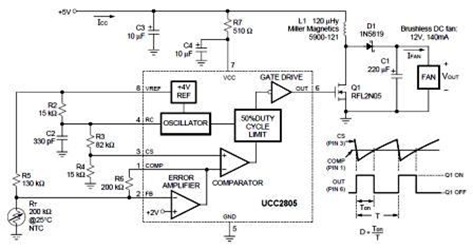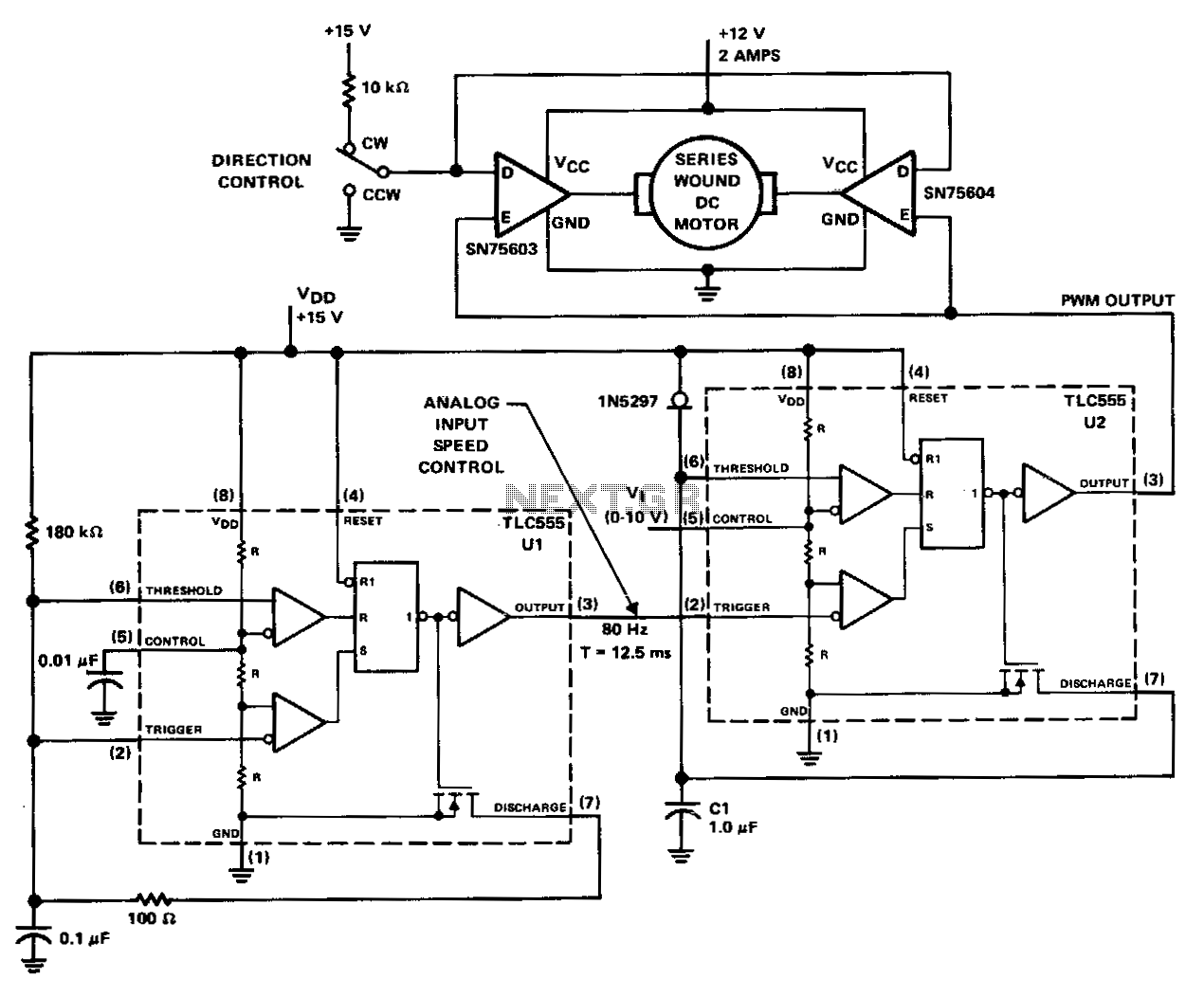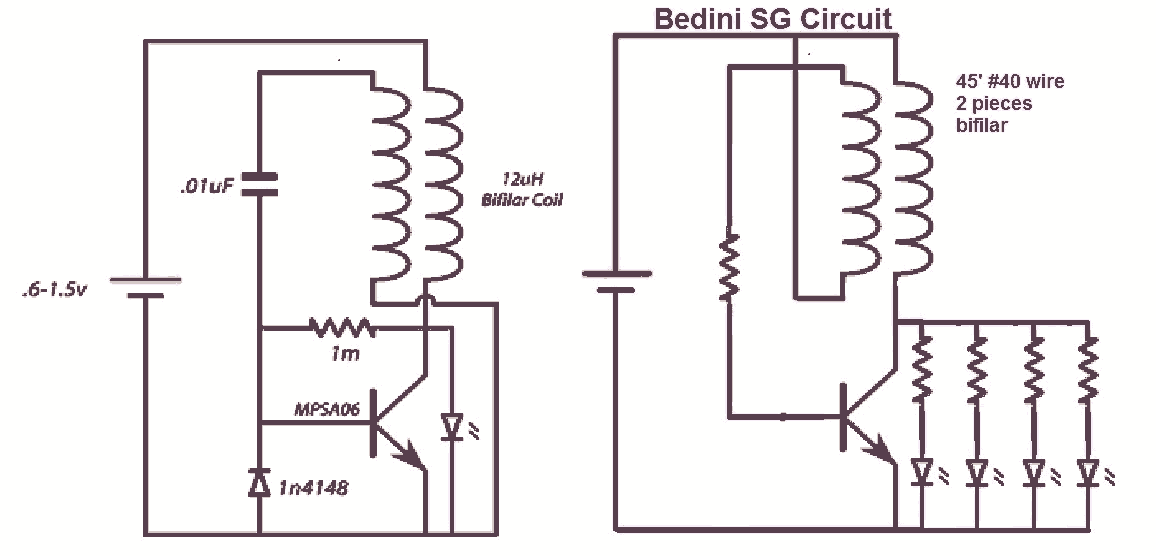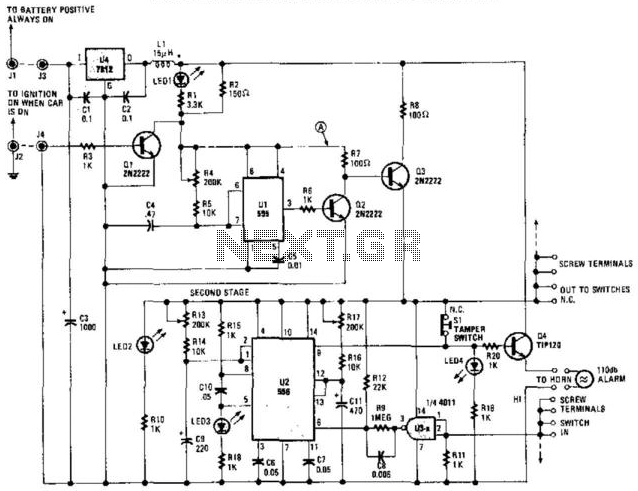
Automatic lighting control circuit diagram composed of optocouplers
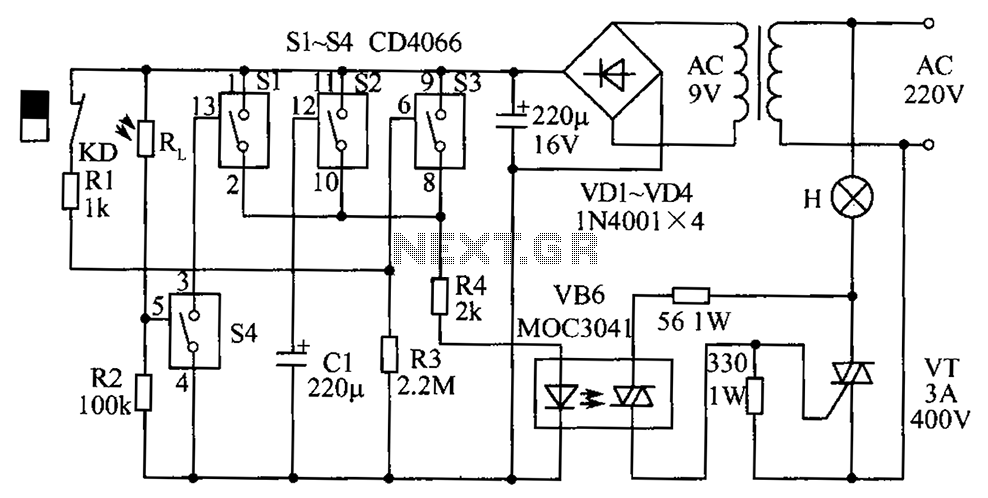
The circuit diagram illustrates a group of four analog electronic circuit switches (S1 to S4). Switches S1, S2, and S3 are utilized in a parallel delay circuit. When the power is activated, resistor R4 drives the triac VT, which directly controls the hall lights (H). Switch S4 is connected to an external photosensitive resistor (RL) for ambient light detection. When the door is closed, a normally closed reed switch (KD), mounted on the door frame, opens its contacts due to the magnet on the door. This action places switches S1, S2, and S3 in an open state. When the homeowner opens the door at night, the magnet is removed from the KD, causing the contacts to close. Subsequently, a 9V power supply is rectified through resistor R1 to charge capacitor C1. The voltage across C1 quickly rises to 9V. The rectified voltage activates switches S1, S2, and S3, along with R4 and the B6-emitting light-emitting diodes, which trigger a bidirectional thyristor, illuminating the light (H) for automatic lighting control. Once the door is closed, the magnet returns to the KD, causing the contacts to disconnect, halting the charging of C1. The circuit then enters a delay state, during which C1 discharges through resistor R3. After a predetermined time delay, the voltage across C1 decreases to the open voltage level of switches S1, S2, and S3 (1.5V or less), resulting in the switches returning to the off state. This action deactivates VB6, cutting off the triac (VT) and extinguishing the light (H), thus implementing a time-lapse function for the lighting system.
The described circuit operates as an automatic lighting control system that integrates both a delay mechanism and ambient light detection. The primary components include a triac, resistors, capacitors, and a reed switch, all of which work in conjunction to provide a seamless user experience. The triac (VT) serves as a crucial element for controlling the power to the hall lights, enabling them to turn on and off based on the door's status.
The operation begins with the door being closed, which keeps the reed switch (KD) in its normally closed state. When the door is opened at night, the removal of the magnet triggers the closure of the reed switch, allowing the capacitor (C1) to charge rapidly. The charging process is facilitated by the rectification of the 9V power supply through resistor R1, ensuring that the voltage across C1 rises swiftly, thus activating the light-emitting diodes and the thyristor to illuminate the hall lights.
The delay mechanism is an essential feature of this circuit. Once the door is closed again, the reed switch opens, interrupting the charging of C1. The capacitor then begins to discharge through resistor R3, gradually reducing the voltage. This discharge process is critical for determining the time duration that the lights remain on after the door is closed. The circuit is designed to ensure that the voltage across C1 falls below the threshold required to keep switches S1, S2, and S3 in the on state, thus turning off the lights after a set delay.
This automatic lighting control circuit is particularly useful for enhancing convenience and safety in residential settings, providing illumination when needed and conserving energy when it is not. Circuit is shown. Group 4 analog electronic circuit switch (S1 ~ S4): S1, S2, S3 for parallel delay circuit, when the power is turned on by their R4, VB6 drive Triac VT, VT dir ectly control the hall lights H; S4 and external photosensitive resistance RL and the like ambient light detection circuit. When the door is closed, mounted on the door frame normally closed reed KD action by the magnet on the door, its contacts open, S1, S2, S3 in the open state.
Night home owner opened the door, the magnet away from the KD, KD contact closure. After this time 9V power rectifier through R1 to charge C1, C1 two Swiss voltage quickly rises to 9V, the rectified voltage by S1, S2, S3 and R4 within the B6-emitting light-emitting diodes, triggering a two-way thyristor, H is lit., automatic lighting control. After the door closed, the magnet control KD, contact disconnect, 9V power to stop charging C1, entry delay circuit state, C1 began to discharge R3, after a time delay, C1 two Swiss voltage is gradually decreased to S1, S2, 83 open voltage (1.5v) or less, S1, S2, S3 resume off state, resulting in off VB6, VT also cut, H off, lights time-lapse function.
The described circuit operates as an automatic lighting control system that integrates both a delay mechanism and ambient light detection. The primary components include a triac, resistors, capacitors, and a reed switch, all of which work in conjunction to provide a seamless user experience. The triac (VT) serves as a crucial element for controlling the power to the hall lights, enabling them to turn on and off based on the door's status.
The operation begins with the door being closed, which keeps the reed switch (KD) in its normally closed state. When the door is opened at night, the removal of the magnet triggers the closure of the reed switch, allowing the capacitor (C1) to charge rapidly. The charging process is facilitated by the rectification of the 9V power supply through resistor R1, ensuring that the voltage across C1 rises swiftly, thus activating the light-emitting diodes and the thyristor to illuminate the hall lights.
The delay mechanism is an essential feature of this circuit. Once the door is closed again, the reed switch opens, interrupting the charging of C1. The capacitor then begins to discharge through resistor R3, gradually reducing the voltage. This discharge process is critical for determining the time duration that the lights remain on after the door is closed. The circuit is designed to ensure that the voltage across C1 falls below the threshold required to keep switches S1, S2, and S3 in the on state, thus turning off the lights after a set delay.
This automatic lighting control circuit is particularly useful for enhancing convenience and safety in residential settings, providing illumination when needed and conserving energy when it is not. Circuit is shown. Group 4 analog electronic circuit switch (S1 ~ S4): S1, S2, S3 for parallel delay circuit, when the power is turned on by their R4, VB6 drive Triac VT, VT dir ectly control the hall lights H; S4 and external photosensitive resistance RL and the like ambient light detection circuit. When the door is closed, mounted on the door frame normally closed reed KD action by the magnet on the door, its contacts open, S1, S2, S3 in the open state.
Night home owner opened the door, the magnet away from the KD, KD contact closure. After this time 9V power rectifier through R1 to charge C1, C1 two Swiss voltage quickly rises to 9V, the rectified voltage by S1, S2, S3 and R4 within the B6-emitting light-emitting diodes, triggering a two-way thyristor, H is lit., automatic lighting control. After the door closed, the magnet control KD, contact disconnect, 9V power to stop charging C1, entry delay circuit state, C1 began to discharge R3, after a time delay, C1 two Swiss voltage is gradually decreased to S1, S2, 83 open voltage (1.5v) or less, S1, S2, S3 resume off state, resulting in off VB6, VT also cut, H off, lights time-lapse function.
